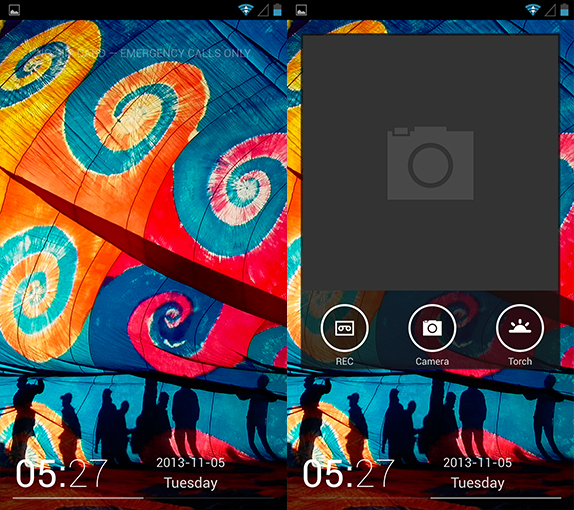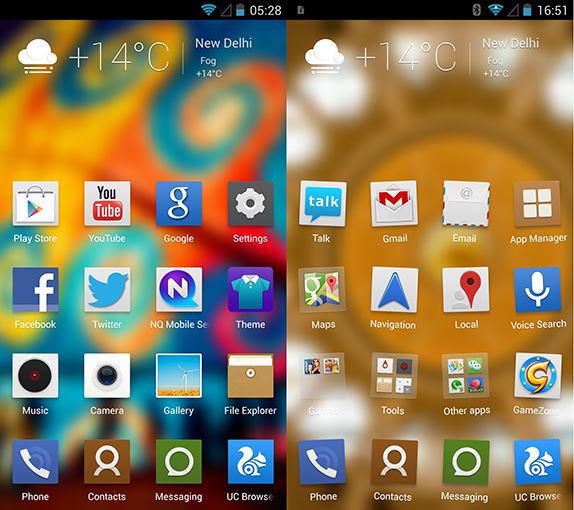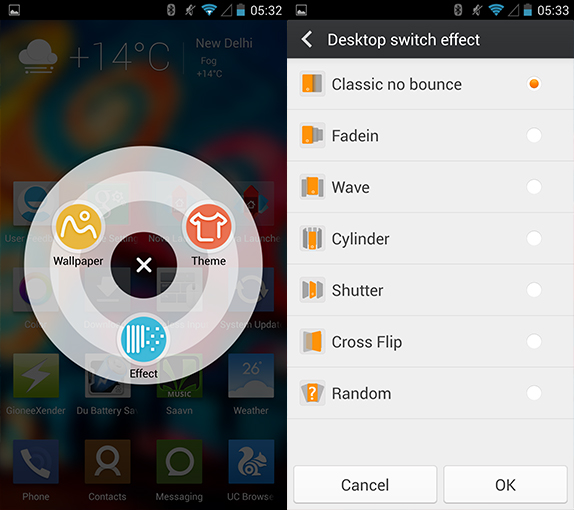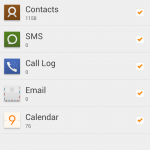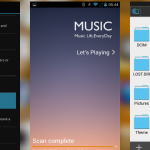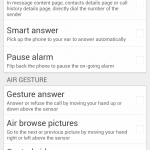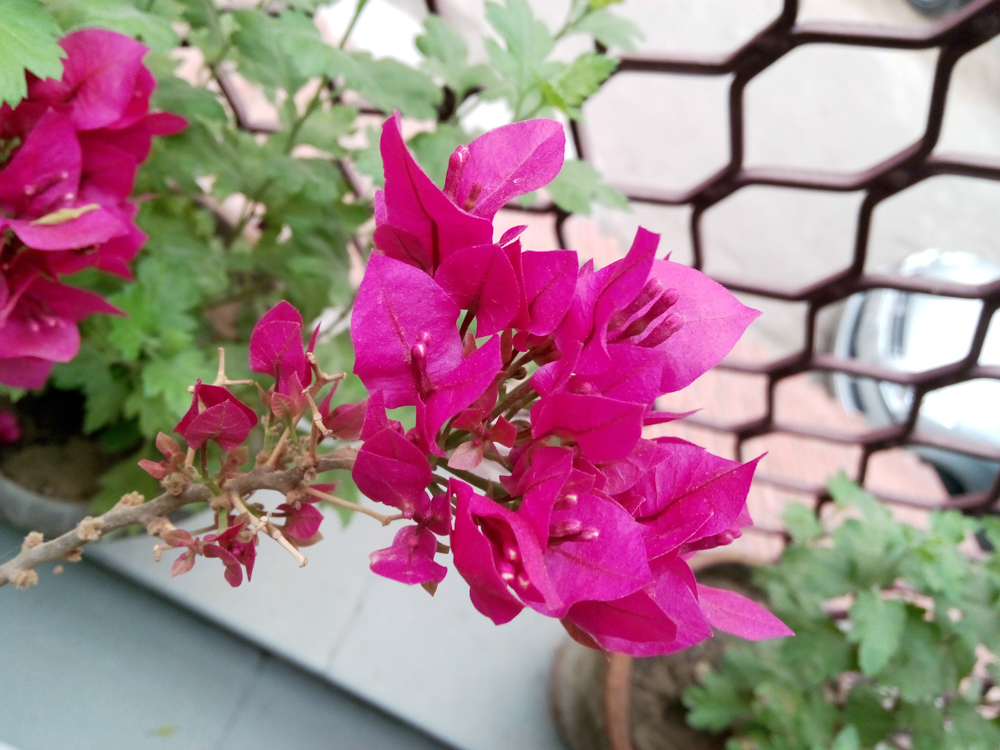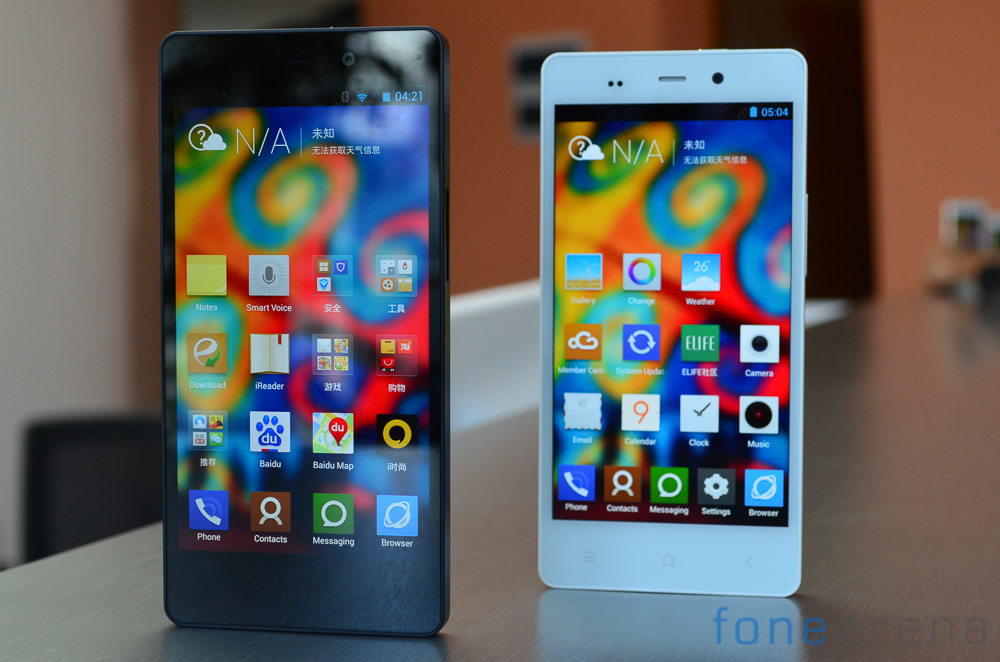
Amongst the many upstarts in the indigenous smartphone scene in India, one specific brand has caught our eye. Gionee has differentiated itself with its refreshing focus on design and hardware quality. Handsets like Elife E3 stood out from the competition being a device that both looked and also offered a very unique experience to the user. With the Elife E6, Gionee is kicking this up a notch. We’d previously done a preview of the device and here’s our review of the Gionee Elife E6.
Video Review
httpv://www.youtube.com/watch?v=JDIEy6EDCS0
Hardware
The company’s flagship device sets the benchmark very high for design in mid range handsets. The phone has a unibody form factor with sharp and clean lines. The material is polycarbonate and feels reassuringly solid. The handset weighs deceptively light.

The front of the phone is reminiscent of the iPhone. Indeed, the handset appears to be a much enlarged version of Apple’s popular smartphone. The screen is a 5 inch panel and is absolutely stunning but more on that later. Above the display is the speaker grille and next to it is a front facing camera. An RGB notification LED lies at the far right corner.
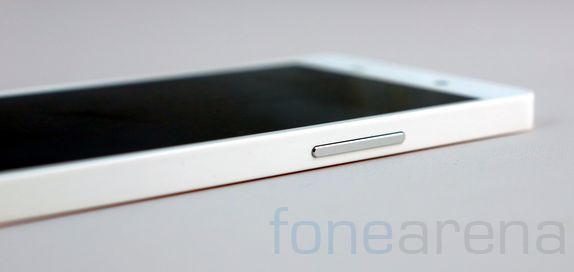
Over on the right side of the phone you spot the volume rocker that lies almost flush with the handset but still manages to provide decent feedback. On the left side you spot the iPhone style SIM card slot. You’ll need a pin to extract your micro SIM card from here. There are no slots for microSD cards on this phone so you’ll have to make do with the built in storage.
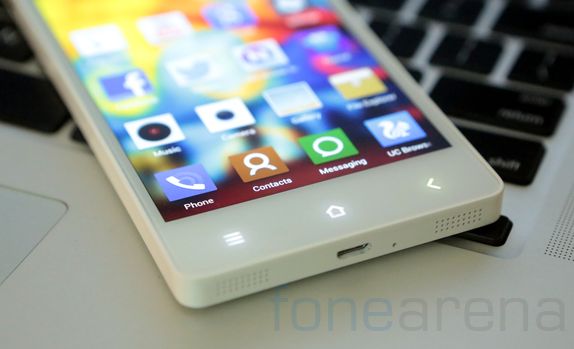
Over at the top is the the 3.5mm audio jack and the power switch. The power switch is slightly off center but not entirely to the right. While holding the phone, your finger rests naturally on top of the button. It is interesting to see this level of attention to detail that is not very common outside of the top smartphone brands. At the bottom is the micro USB slot with the two speaker grilles next to it.
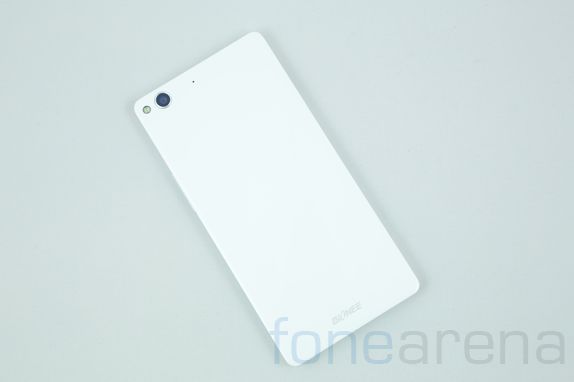
The back of the handset is a swathe of pearly white plastic with a high gloss finish. Surprisingly, this does not look tacky at all. The high quality plastics used ensure that the handset in fact looks and feels just as good as a top end Lumia device that uses similar materials. To the top left corner is where you see the 13MP camera with a single LED flash. The Gionee Elife E6 is a stunning device with a slim 8mm profile that manages to slip into any pocket. Yes, the handset does have a fairly large footprint but that’s true for most phones with a 5 inch display.
Software
While the specifications of most phones are at par, software is often the differentiating factor. On the Gionee Elife E6, this is truer still. The handset runs a fork of Android called Amigo. The system has been built on top of Android 4.2 and offers deep rooted battery optimizations. The interface is visually appealing and follows similar interface principles as the iPhone. There are animations aplenty and that’s where things start to break down a bit. We’ll talk about that in the performance section but for now, let’s walk through the interface of the Elife E6.
The lockscreen on the E6 is the first thing that you notice on the phone. It is a very clean and modern looking affair though information junkies might not be too impressed. Swiping over from the right brings you a widget that lets you toggle on the torch, camera or sound recorder directly. Worth noting is that the camera toggle does not trigger the full app instead opens the viewfinder in the small space above it.
What strikes you at first glance is that there is no application sub menu in the interface. Like on iOS, all application icons are placed on the homescreen launcher directly. A perpetual weather widget is placed at the top of the homescreen and below it are app icons. You can drag and drop them on top of each other to place them into folders. At the bottom is a row of persistent icons that is set to the dialer, contacts, messaging app and UC browser by default but you can switch this out for anything else.
Customization includes the ability to switch out the theme, wallpaper as well as transition effects. The themes essentially consist of preset variations on the effects, wallpapers. We’d recommend sticking with the ‘no bounce’ effect as the others do take a fairly heavy toll on performance.
Gionee’s Android fork includes a backup utility built in as well as gestures support. These make use of the accelerometer and / or the front camera and your experience with them will vary though they work well enough for the most part. The multitasking menu has been switched to a card switcher that once again reminds you of iOS and in this case, Windows Phone. We’re not entirely sure this was a good move either as unlike the default Android app switcher, this one requires a lot of scrolling if you have multiple apps open. Overall there are some curious design choices that permeate throughout the operating system. The interface looks really good and borrows elements from the many different skins on other phones. This amalgamation however results in a skin that is heavy on graphical elements, transitions and has a negative effect on performance.
Performance
Moving on to performance, the handset is powered by a 1.5Ghz Quadcore MediaTek MT6589T processor paired with a PowerVR SGX 544MP GPU. There’s 2GB of RAM and 32GB of built in storage. Of this, about 23GB is available. While the specifications on paper sound quite adequate, the fact of the matter is that the interface layer on the phone is just a bit too heavy for the processor to handle. As it is, the MT6589T chip struggles with a stock Android build when paired with a Full HD display, here the added animations cause the phone to stutter through out the interface.
httpv://www.youtube.com/watch?v=owiPdLsz-VY
Applications on the other hand are smooth for the most part. Using an alternate launcher is a good way to hide the interface lag related problems. While not very indicative of real life performance, you can check out some of the synthetic benchmark results below.
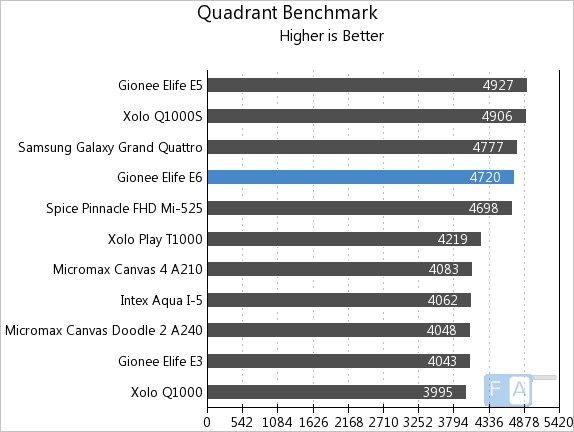
In the CPU centric Quadrant benchmark, the phone does fairly well and is ahead of most of the competition with a score of 4720 points. The Elife E5 manages to rank further up though because of the lower resolution screen that it has to power and hence better performance.
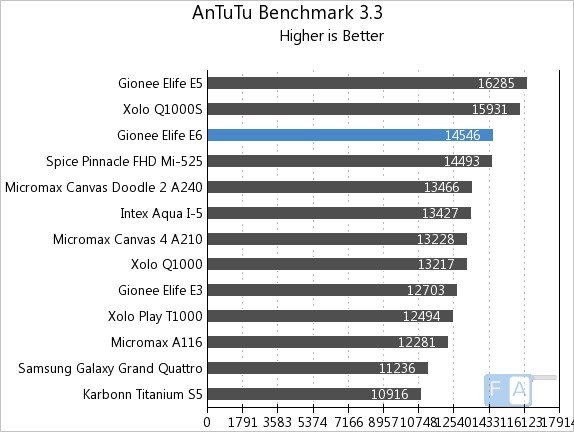
We see the same trend continue with AnTuTu as well wherein the phone performs quite well and is ahead of most of the competition with a score of 14546. That said, the two competitors above the E6 beat it by a fair margin.
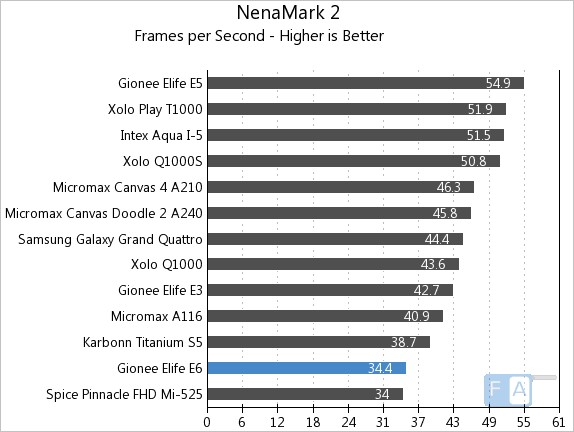
The NenaMark 2 benchmark reveals the sore point in the hardware of the Elife E6. The GPU isn’t really up to the job of powering a Full HD panel and when encumbered with the heavy skin as seen here, it has a direct effect on performance.
We tried out some games on the device. Here is the Shadow Gun gameplay on the Elife E6. The gameplay and the graphics were smooth.
httpv://www.youtube.com/watch?v=oV4JSHXEWgA
Check out the Ashphalt 7 gameplay. The graphics were good, but the gameplay was laggy.
httpv://www.youtube.com/watch?v=a7nZFTitTbs
Check out the Gaming review which test the gaming performance of the device with games such as Riptide GP2 and Iron man 3. Overall the gaming performance was average with occasional lags.
httpv://www.youtube.com/watch?v=hSK1tiwsxYM
Display
Without a doubt, the screen on the Gionee Elife E6 is gorgeous. In fact, it is one of the most beautiful displays we have seen on any phone. The resolution is 1920 x 1080 and pixel density amounts to ~ 441ppi. Color reproduction tends to be a bit oversaturated but brightness levels are top notch. The display also has some of the widest viewing angles we’ve experienced lately.
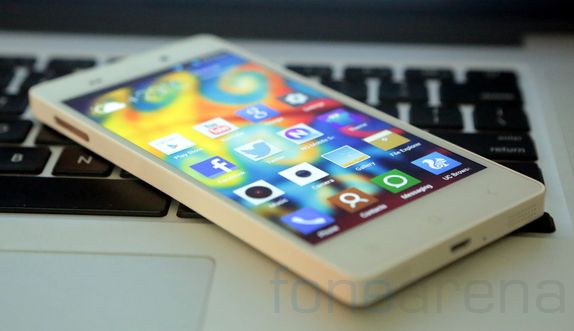
Sunlight visibility is good but not the best but that’s a formula that only Nokia seems to have perfected so far. Put next to Full HD display phones from the likes of HTC and Samsung, the panel on the E6 shines and gives them a stiff competition. The screen is of the One Glass Solution (OGS) variety that has a bonded glass and display panel. This ensures better viewing angles and brighter colors.
Camera
httpv://www.youtube.com/watch?v=tydZC7wxAcU
Gionee is sourcing the 13MP camera modules from Sony and it has second generation BSI technology for better low light imaging. The camera module sourced from Sony has the Exmor R sensor. Despite that we weren’t too impressed by shots from the phone, images in anything but excellent lighting show grain and inaccurate white balance.
As can be seen above, the camera struggled with the shot and a lot of details were lost especially in the green areas due to rather aggressive noise reduction algorithms.
The limited dynamic range was visible here as the camera has completely overblown the highlights and has lost all details in the background.
Macro focussing on the camera is pretty decent and you can get close up shots quite easily. You’ll want to hold the phone very steady though as the shot to shot time isn’t the fastest and images tend to turn out blurry.
httpv://www.youtube.com/watch?v=cEdGQLYNnEc
Video quality is decent though we noticed that framerate drops were fairly often. An EIS (Electronic Image Stabilization) mode is also available that we found to be surprisingly effective in removing camera shake given the lack of optical image stabilization in the module.
Battery Life & Connectivity
The Gionee Elife E6 is equipped with a 2000 mAh battery that generally proved to be enough for a day of fairly heavy usage. You’ll definitely have to charge it up overnight though. Software optimizations on the phone play a major role. Gionee claims that the handset will lose a very minimal charge even when keep on standby for long durations. Other optimizations include active management of connections to facilitate longer battery life. Overall we were fairly satisfied by the results we got here. Connectivity options include 3G, WiFi 802.11 b/g/n, Bluetooth 4.0 and GPS. The sensors onboard range from Proximity sensor to the G-sensor, E-Compass, Gyroscope Sensor and Light Sensor. There’s 32GB of storage on the phone of which about 23 is available and you cannot expand this either.
Conclusion
The Gionee Elife E6 is part of a rare breed of phones that have a very design oriented bent. The handset has a design that can possibly be termed as an instant classic. Not only is it ergonomic but also genuinely beautiful though perhaps not the most original. However that’s where majority of the positivities end for the most part.

The performance is middling and the processor isn’t really up to the task of powering the Full HD panel. More so with the heavy animations and transition effects across the interface. The camera module too doesn’t really impress. If your requirements from a phone are fairly minimal and all you want is a sleek and fashionable Android phone, then the Gionee Elife E6 will definitely fit the bill but performance junkies might want to look elsewhere. The Elife E6 retails for Rs. 22,999.
Pros
- Beautiful hardware
- Visually attractive interface
- 32GB storage
Cons
- Performance
- Average camera
- No expandable storage

